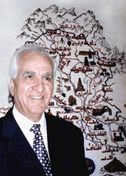Visiting Cemeteries
Tourism of Open Museums
It is a strange title for an article just as strange, arousing astonishment and questions.
Before reading this article, I ask the reader to take a pen and a paper to record everything that goes through his head about this title.
Are you ready?
We begin this topic by highlighting the relationship of cemeteries to human history. When humanity researches its history and civilizations, it often finds clay or stone objects, manuscripts, seals, various tools and utensils, near cemeteries, and many times in their midst, artefacts of different cultures and customs of various peoples, belonging to successive civilizations.
Thus, cemeteries are closely related to the history and geography of places and their inhabitants over centuries. They have a massive mental and emotional impact on researchers, archaeologists, historians, tourists and the general public. Why not? They are the homes of the ancestors.
These archaeological sites have attracted thousands of scientists and researchers, and a considerable number of workers to dig up the past. Many countries have spent considerable funds to finance excavations over the decades, even today, and they annually reveal more secrets and treasures that deepen our knowledge of our roots.
Because of their historical, architectural, artistic and symbolic value, many cemeteries have become important World Heritage Sites, such as Makli cemetery in Pakistan, the pyramids of Egypt, which were awarded the World Tourism Organization’s prize in 2007 for best tourist attraction worldwide, and the Taj Mahal, which became a symbol of love and loyalty.
No wonder, therefore, that countries spend millions or even billions of dollars for the excavation and restoration of their cemeteries, hoping to attract tourists to such sites, or even other tourists who do not come primarily to visit them but they could be included in their programme to enrich their trips.
Experiences and observations
Based on my travels for over sixty years, I discovered many cemeteries and mausoleums, from a visit to the tomb of the Prophet Mohammed (PBUH) and the Baqii cemetery in Medina, the mausoleums and tombs of imams and saints in various parts of the world to which Muslims make their pilgrimage, as well as other cemeteries. I would like to recall some observations:
-- The Cemetery Wadi Es-Salam in the holy city of Najaf: This cemetery is more than 1400 years old, and it is considered one of the most important cemeteries in the world. It is also the largest in the world. Wadi Es-Salam (the Valley of Peace), is not only the cemetery of Najaf or Iraq but countries such as Iran, India, Pakistan, Afghanistan, Kuwait and Lebanon among others bury their dead there. It also draws visitors from these countries. This cemetery is blessed because it houses the tombs of Prophets and Hud and Saleh, as well as those of many saints and scholars and believers who have opted for this cemetery since it was known that Imam Ali Ibn Abi Taleb is buried there. Thus, there are tombs of kings, presidents, ministers and ordinary people. As a result, this cemetery is the history of Iraq, through the knowledge of ages and causes of death. Thus, there is Iraq of the plague, Iraq of floods, Iraq of the wars of the former regime, Iraq of terrorist operations, etc.
-- Madain Saleh in Saudi Arabia: I visited this site last year, following the kind invitation from the Saudi Embassy in London, as part of a British delegation composed of tourism writers and journalists to discover major tourist sites, and the natural heritage of the country.
Madain Saleh was inhabited by the Thamud tribes in the mid-4th millennium BC, and after them came other people such as the Nabataeans. It is one of the oldest legacies of the Arabian Peninsula. This cemetery is home to more than 120 family tombs carved in rocks, some of which are described as "palaces", because of their surprising beauty. They also include Thamudic and Nabatean engravings which still deserve to be decrypted. In 2008, UNESCO included Madain Saleh in its World Heritage List. It therefore became the first cemetery that received the attention of the Saudi authorities to use to attract tourists, and it is also the first Saudi site included in this list.
-- The Normandy Cemetery on the French Atlantic coast: I visited Normandy and the Loire, through a travel agency. I saw the graves of Allied soldiers who contributed to the liberation of France during World War II, landing on the beaches. Our guide introduced us to the site and its history.
-- The cemetery of ancient Rome, when I visited Rome, I saw, amongst other things its cemetery, located under the ancient city of Rome. I saw there many surprising things, due to its many labyrinths in the basement and its height which exceeds 10 metres. The tombs are placed in various floors a few centimetres from each other. Even after fifty years, its image is still embedded in my memory.
Other Visits
I have visited a large number of cemeteries either on bus tours or by walking through cities. The guides did not miss any opportunity to explain to us the main features and history of the cemeteries and the famous personalities who were buried there. Their beautiful landscapes of trees and flowers carefully arranged gained my admiration and exited my imagination.
Similarly, visits to churches, with their tombs and statues draw attention to the person buried, provide important information about priests and clerics of different ranks, especially in the Catholic churches, such as the Vatican, the Dome of Milan, the Dome of Cologne, Notre Dame the heart of Paris, and others.
Add to this the statues and frescoes that tell the names and history of personalities and who adorn the squares of cities, recalling the commemorated people, in a similar way to the graves.
This is just a small part of what I observed in various countries around the world. Even now, I still have photos of these sites.
Benefits of the visits
From the foregoing, it appears that the reason and cause of these visits include many aspects and perspectives which we must be attentive to, so as to figure out ways of developing them for tourism purposes. We cite here the most important aspects:
-- Faith and humane aspects
Muslims have preserved sites and names of Imams who had fought alongside the Prophet (PBUH) and those imams and saints who followed. Their mausoleums and shrines are scattered in various parts of the world. They were built in fine architectural styles, and around them developed prosperous cities. Initially, the tombs were simple in arid lands; but subsequently they have become holy sites attracting visitors and tourists from different countries.
Islam has attached great importance to faith values which are embodied in the life of the Prophet's companions, imams and saints. Generations had cared for their words, their life stories and their tombs. As proof, Al Bakii cemetery is still known as the graveyard of imams and the companions of the Prophet, even after its destruction, as a result of interpretation by some clerics who went against the good judgments of the scholars of all other Islamic schools from early Islam until today.
We implore the clerics of Saudi Arabia to review the fatwa on the destruction of tombs, because of its tragic consequences in Afghanistan, Iraq and other countries, as well as the negative image of Islam that it has created and that all Muslims have disapproved of.
The restoration of Al Bakii cemetery has many advantages for the Muslim world, the most important one being the building up of the unity of Muslims and highlighted the faith that is represented by the course of life of the companions of the Prophet and Ahlu Al Bayt (the Family of the Prophet). Saudi Arabia would be the first beneficiary, because it is not only the custodian of Mecca and the tomb of the Prophet in Medina, but also the supervisor of the Islamic Renaissance and the history of Muslims, in all their trends and doctrines. They should refute all fatwa’s calling for killing, and destruction of mosques, mausoleums, shrines, graves of saints, and anything that leads to division, in order to show the ideals of our Islamic values.
-- Social and psychic aspects
Without doubt, visiting the graves of relatives and friends has many moral and educational aspects permeated with lots of psychological and social meanings. Such a visit shows a personal loyalty to the beloved and a keeping up of their memory. It also gives consolation and psychological therapy to the sense of their loss. Whatever the rituals practiced by the visitors, which are very diverse in different cultures and customs, the administrators of these places should be familiar with and should provide the materials and the appropriate atmosphere. The result is the same, namely that the person feels peace in his soul for having accomplished what he believes to be its duty for his parents and relatives.
-- Economical and Planning aspects
These aspects are clearly manifested in the fact that multiple cities or sectors in these cities, particularly in the Muslim world, have grown economically due to the presence of a mausoleum or a shrine, which attracts thousands or even millions of visitors. The latter becomes the economic base of the city, around which other sectors grow such as education and services. One example is the city of Karbala, which is visited by tens of millions of Muslims throughout the year, particularly during religious festivals. This is also true of the cities of Najaf, Kadhimiya and others.
-- Historical and cultural aspects
Cemeteries have a great historical importance, as is the case of the pyramids in Egypt. Certainly, anyone who wants to visit the Great Pyramid today is not primarily going for the tomb of the Pharaoh Khoufou, but rather the history, civilization and culture of the Nile, represented by this impressive building. We could think of it as a time machine in which we can return to those days.
-- Architectural and artistic aspects
Some cemeteries have architectural, artistic and exceptional craftsmanship, which no modern museum could match. This applies to the cemetery Makli in Pakistan, which was described in a previous issue of our magazine. The elements and architectural details included in the arches, columns, balconies, halls and domes of mausoleums of ancient rulers, attest to the splendid professional skills of the old architects.
As for the Taj Mahal in India, it needs no introduction. Suffice to say that 20,000 artists, calligraphers, engravers and architects worked for 20 years to make this mausoleum a symbol of love and fidelity, one of the Seven Wonders of the World, a school of arts and an inspiration to poetry.
Thus, it is not surprising that tourism of the cemeteries is tourism of open historical and artistic museums.
May God guide us to success.
A. S. Shakiry
|

